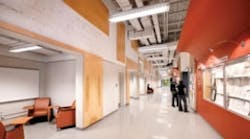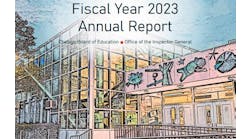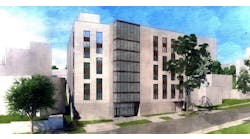We spend too much time managing the 30 percent. In higher education, most of what a student learns is learned outside the classroom—up to 70 percent, according to the U.S. Department of Labor. Yet we spend very little, if any, time worrying about or designing appropriate learning environments outside classrooms.
In a presentation on TED.com titled "Why We Don’t Understand As Much As We Think We Do," British educational media consultant Jonathan Drori argues that learning without a strong experiential component may miss the mark.
"Children get their ideas not from teachers, as teachers often think, but from common sense, from the world around them, from … experience." And when we gain our knowledge only from teachers outside of the real-world context, the knowledge often is without understanding.
The truth is that most classrooms really are places created for the convenience of teaching and not as the best places to learn. Have you ever wondered why some schools move the students from room to room instead of the teachers? Or why the teacher’s desk is at the front of the room and the seats in an austere row-by-column configuration? Everything about the typical classroom clearly is about the instructor-teacher and not the student-learner experience.
We probably won’t do away with classrooms anytime soon—but we should be taking a broad design approach to learning environments that goes well beyond the classroom and encompasses the whole of the student experience. A school or college campus should foster a deep cross-section of learning experiences that supports a hands-on inquiry and engages students in a passionate search for knowledge—in other words, the anti-thesis of what often is the hallmark of many institutions. Not the big white box, sage-on-stage approach we’ve taken for the last 150 years, but a much more contextual, immediate and active learner-centered approach.
Five steps to the future
What would this learner-centered campus look like? Five important characteristics affect the buildings and outdoor spaces associated with an education institution:
•Active. Learning spaces are active spaces. Shun any idea that a student is a passive reservoir into which a teacher pours knowledge. Instead, seek out spaces that force students to engage actively with the knowledge content. Art studios and science laboratories always have been this way, but for the most part we haven’t been able to achieve the same level of interactivity in liberal-arts pursuits. Spaces that foster critical discussion, provide access to multiple forms of content, and entice the instructor off the podium and into the arena may be able to do for the liberal arts what we have done for the arts and sciences.
•Group-friendly. Students learn better when they are taught by each other than when they are taught only by a teacher. When students learn from each other, many good things happen. Instead of learning at the pace dictated by the instructor, they learn at a pace that is student-centered. They learn through the lens of their peers whose experiences—though obviously different than theirs—have generational similarities. They develop an understanding adequate to enable each to verbalize the key concepts. The spaces that foster this interaction focus on multiple small groups seated around round tables where no student is of greater stature than any other; contexts can range from formal conference room-like space to the very informal niche off the active corridor space.
•Highly interactive. Some people may say highly interactive environments already have been achieved through the explosion of electronic communications. Cell phones and the text-messaging phenomenon have changed the way students interact on campuses.
Remember when it was difficult to get in touch with another student during the day? Today, students can communicate with any other student (for whom they have a phone number) at any time quite easily. Even those they don’t know can be contacted through a Facebook or other social media account.
As powerful as these new technologies may seem, they have not revolutionized student interaction. And, they have had little positive influence on student-teacher interaction. The latter type of interaction, which supports learning with understanding, must be directed to a common goal, and be relatively low-risk for the participants.
Why low-risk? When these interactions become the basis for broad assessment (i.e., they have a major impact on a grade), students instinctively pull away from them. When risk is relatively low, the educational results can be quite exciting, as well as long-lasting.
More and more spaces on campuses are facilitating this kind of interaction and supporting group work in flexible, student-controlled environments. They tend to be called "student lounges" or "studio classrooms" these days, and they are large, flexible, 24/7 lab-like spaces with easy access to digital resources, food and other student comforts, where faculty reside as mentor-resources to students engaged in the same real-world issues. These spaces should be available in every campus precinct.
•Contextual. Isn’t it odd that we prepare for a career in an office by taking classes in a classroom? In fact, contextualizing what we learn is an enormous problem. Many students simply can’t apply what they learned to real-world phenomena.
So how do we fix this? In his book, The Schools Our Children Deserve: Moving Beyond Traditional Classrooms and Tougher Standards, Alfie Kohn addresses the issue head-on by using the example of how we learn to drive. We don’t learn by breaking the activity into multiple pieces and learning each piece, or by practicing only portions of the activity, such as how to turn a steering wheel or how to use a turn signal. We learn by getting behind the wheel and doing it all at once—and not so well at first. This enables us to master a relatively complex task in a short period of time.
We need to take this learning-to-drive concept on the road, no pun intended. If we want to learn something, we should learn the phenomenon in its real-world context all at once with all its complexity. School and campus facilities that do this well have a broad cross-section of environments that either replicate a multiplicity of real-world contexts or actually are an example of the real-world context. Virtual-reality games or any game that replicates a real-world context accomplish the same end and can be very effective pedagogically.
•Connected. Connectivity has become a technology buzzword, but in the context of learning we should be most concerned with being connected to knowledge content. That can mean the Internet or a library database, but what is probably the most important for students is a connection to courses and course-related content. Being connected enables students to customize their learning experience and learn in the way they learn best.
Everyone has different strengths when it comes to learning. Winston Churchill did his best thinking when he was moving around; he was what is known as a kinetic learner. By having a number of tools at his or her disposal, any student can determine how best to interact with the content to achieve the best results.
The most obvious way spaces can promote connectivity is to provide easy access to a school’s or campus’ digital network. However, for students to take advantage of this connectivity, schools need to go above and beyond simply providing a connection; they should provide space for the learning to occur. Because education institutions need to support a broad cross-section of learning types, they need a similarly broad cross-section of spaces.
The best way to do this is consider the entire school complex or college campus—or at least a campus precinct—as providing this cross-section of space typologies. If connectivity can be achieved nearly anywhere on campus, which isn’t terribly difficult given the wired and wireless options available, then each campus precinct should include a broad spectrum of formal and informal, group and individual, and low- and high-interaction spaces that can be accessed by students outside of class time.
Creating learner-centered campuses takes time. Curricula and pedagogies will change before the spaces will, but schools and campuses that can make these changes will find that they serve learners better and create more vibrant and engaging places for everyone.
More resources
For more information about how new technologies can benefit learning environments:
•Visit Educause’s website at www.educause.edu. This nonprofit association strives to advance higher education by promoting the intelligent use of information technology. Learning Spaces, an e-book edited by Diana G. Oblinger, shows how spaces can affect how we learn and how technology can enhance that experience. The e-book can be downloaded for free on the website.
•SCALE-UP (Student-Centered, Active Learning Environment for Undergraduate Programs) is a project established by North Carolina State University and funded by the U.S. Department of Education, the National Science Foundation, Hewlett Packard, Apple Computer and Pasco Scientific to create highly collaborative, technology-rich interactive learning environments for large (100 students or more) classes. More information is available at the SCALE-UP website: www.ncsu.edu/per/scaleup.html.
•The National Survey of Student Engagement (NSSE) also provides assessments on the student classroom experience. CLASSE, the Classroom Survey of Student Engagement developed by researchers Bob Smallwood of the University of Alabama and Judy Ouimet of Indiana University, uses student and faculty surveys to help teachers and learners focus on pedagogical improvements that can enhance student engagement and improve student success. Institutions can participate at no cost through a licensing agreement with NSSE. More information is available at www.nsse.iub.edu/index.cfm.
Zaiser, AIA, is a partner at KSS Architects, a firm with offices in Philadelphia and Princeton, N.J., that specializes in the design of learning environments for schools and higher-education institutions across the nation. He can be reached at [email protected].



